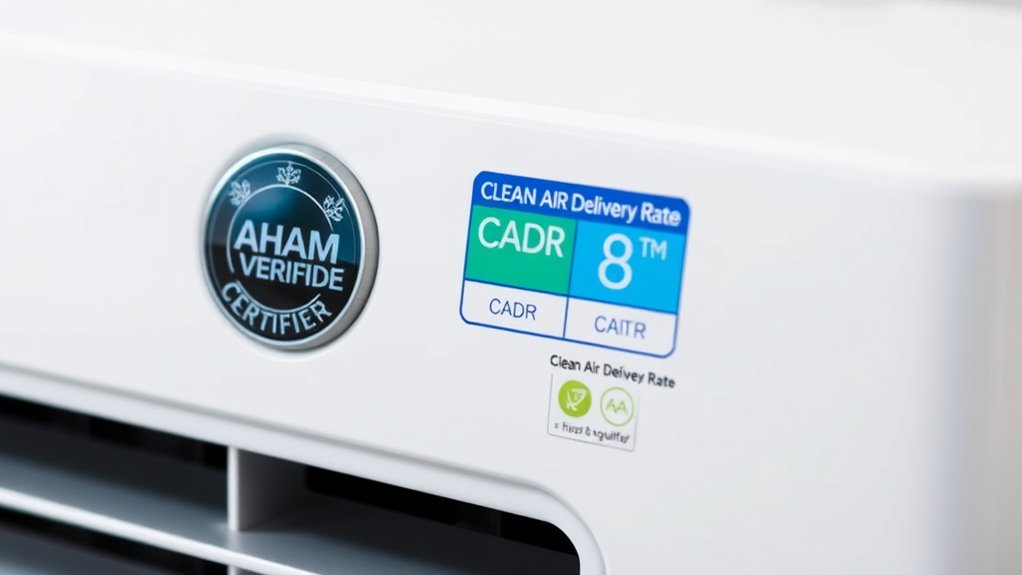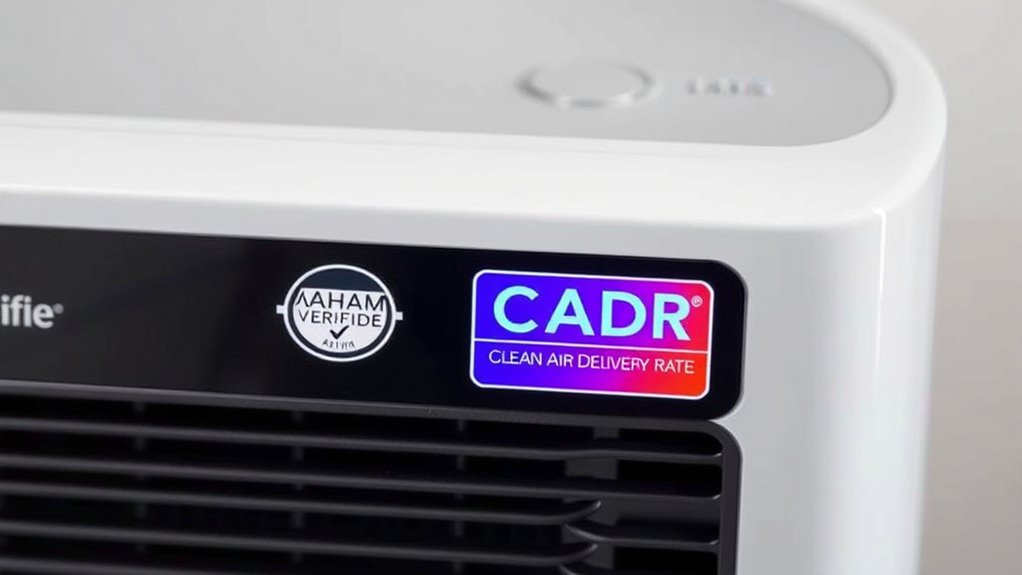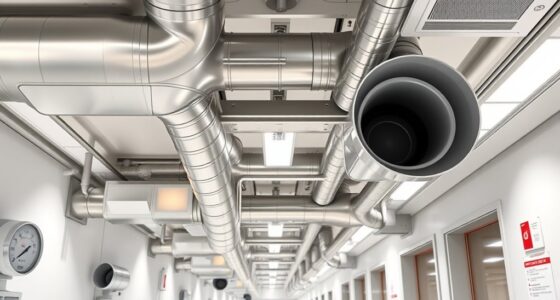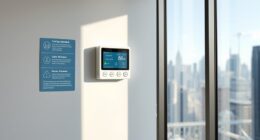Air cleaner labeling programs like AHAM Verifide and Clean Air Delivery Rate (CADR) help you identify effective devices by providing independent, verified performance standards. The AHAM Verifide mark guarantees the cleaner meets strict testing for airflow, filter efficiency, and energy use. CADR ratings show how quickly the unit removes pollutants, helping you match it to your room size. Keep exploring to learn how these labels can guide your choices for healthier indoor air.
Key Takeaways
- The AHAM Verifide mark certifies air cleaners meet independent performance standards through rigorous testing.
- Clean Air Delivery Rate (CADR) quantifies pollutant removal speed, aiding in matching units to room size.
- Certification programs ensure label claims reflect actual efficacy, reducing reliance on marketing alone.
- Consumers should look for AHAM Verifide and high CADR ratings to select effective, reliable air cleaners.
- Standards cover airflow, filtration efficiency, and energy use, ensuring consistent, measurable performance.

Have you ever wondered how to quickly identify the most effective air cleaners for your home? The answer lies in understanding the labeling programs that assess and verify their performance. Two key tools are the AHAM Verifide mark and the Clean Air Delivery Rate (CADR). These labels provide clear, reliable information about an air cleaner’s efficiency, helping you make informed choices. When evaluating different units, pay close attention to the filter technology used, as it directly impacts how well the device captures pollutants. Whether it’s HEPA filters or activated carbon, knowing the filter technology helps you determine if the cleaner can handle the specific contaminants you’re concerned about, like allergens, smoke, or odors.
Certification standards are the backbone of these labeling programs. They set the baseline for testing and verifying an air cleaner’s performance, ensuring that what’s on the label matches real-world results. The AHAM Verifide program, run by the Association of Home Appliance Manufacturers, tests air cleaners against strict criteria for airflow, filtration efficiency, and energy consumption. When an air cleaner bears the AHAM Verifide mark, it means the device has successfully met these standards through independent laboratory testing. This certification gives you confidence that the product performs as advertised, rather than just promising high results on marketing materials.
Certification standards ensure air cleaners meet strict testing criteria, confirming performance beyond marketing claims.
Similarly, the CADR rating offers a straightforward way to compare air cleaners. This number indicates how quickly a device can reduce specific pollutants—like tobacco smoke, dust, or pollen—in a given space. Higher CADR values mean faster and more effective pollutant removal. Manufacturers typically publish CADR ratings based on standardized testing procedures, which align with certification standards to ensure consistency. When choosing an air cleaner, matching the CADR rating to your room size guarantees exceptional performance. For example, a higher CADR is better for larger rooms or spaces with significant pollution sources.
Additionally, understanding testing procedures and how they simulate real-world conditions helps you assess the reliability of these labels. Ultimately, understanding these labels and standards empowers you to select a device that truly works for your needs. Look for units with the AHAM Verifide mark and high CADR ratings suited to your room size. Confirm the filter technology to ensure it can handle the specific pollutants you’re targeting. By using these verified performance indicators, you avoid misleading claims and invest in an air cleaner that delivers clean, healthy air. Informed decisions like these make a real difference in creating a safer, more comfortable environment for you and your family.
Frequently Asked Questions
How Often Are Air Cleaner Labels Updated or Reviewed?
You should know that air cleaner labels undergo renewal and review approximately every one to two years. The review frequency guarantees the information stays accurate and reflects any product updates or improvements. During this period, manufacturers may update the label details, so it’s a good idea to check for the latest version regularly. Staying informed about label renewal helps you make confident, well-informed decisions when choosing an air cleaner.
Do Labeling Standards Differ Internationally or Just Within the U.S.?
Think of air cleaner standards like a global map—some regions follow the same routes, while others chart their own. International standards do exist, but they often differ to match regional compliance needs. You’ll find variations in labeling requirements across countries, so always check local regulations before buying. This guarantees your air cleaner meets specific regional compliance, giving you cleaner air and peace of mind whether you’re in the U.S. or abroad.
Can a Product’s Label Change After Initial Certification?
Yes, a product’s label can alter after initial certification if there are updates to the label for accuracy or new testing results. You should check for label updates to verify label accuracy, as certification validity depends on current info. Manufacturers are responsible for maintaining accurate labels, and any changes should be reflected promptly to meet standards and keep consumers informed about the product’s performance and certification status.
Are There Penalties for Mislabeling or False Advertising?
You should know that there are legal consequences if you mislabel or falsely advertise your product. Authorities enforce penalties to protect consumer trust, which is vital for your reputation and business credibility. Misleading labels can lead to fines, recalls, or lawsuits, damaging your brand long-term. Ensuring accurate labeling fosters trust, and prevents legal trouble, helping your product stand out honestly in the marketplace.
How Do Labels Account for Different Room Sizes and Usage?
Labels account for different room sizes and usage scenarios by clearly specifying the Clean Air Delivery Rate (CADR) for each size and type of pollutant. You can match your air cleaner to your room size by checking these CADR numbers, ensuring efficient filtration. For various usage scenarios, labels often highlight ideal settings or recommended room dimensions, helping you select the right model for your specific needs.
Conclusion
So, next time you see those air cleaner labels, remember they promise cleaner air but might just be a shiny badge. You’d think a little verification would guarantee fresh, pure air, right? Instead, you might be unwittingly breathing through a filter that’s all show and no go. Ironically, those labels aim to assure you, yet they can leave you wondering if your home’s air is truly cleaner or just cleverly advertised. Choose wisely—your lungs deserve honesty, not hype.










